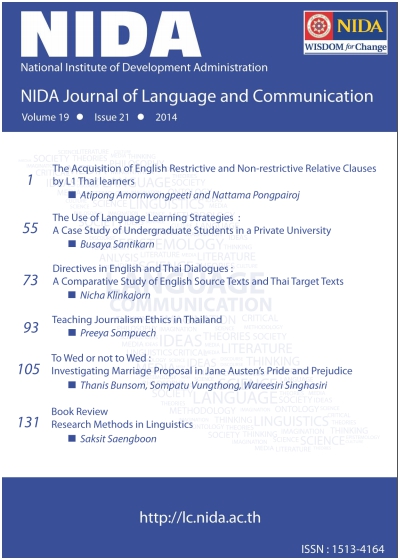Directives in English and Thai Dialogues: A Comparative Study of English Source Texts and Thai Target Texts
Keywords:
Directives, Speech act, Pragmatic formula, Politeness strategy, Cross-cultural pragmatics, Translation strategyAbstract
In this study the researcher intends to investigate the pragmatic formulas and politeness strategies in directives in English and Thai dialogues from the English source texts (STs) and Thai target texts (TTs), as well as to examine the translation strategies used in translating the directives from English into Thai. The data of the study are 147 directive utterances in dialogues from the English fiction, Turning Thirty (2000) and its Thai translated version. It is found that in performing the directives, both the English STs and Thai TTs use the same pragmatic formulas and politeness strategies, but in different ratios. The pragmatic formulas used in the directives both in English STs and Thai TTs are composed of two elements: the “headact” and the “supportive move”. There are two main groups of the pragmatic formulas in the directives both in the English STs and Thai TTs: the formulas with and without supportive move(s). As for the formulas with supportive move(s), both a single supportive move and multiple supportive moves are found, and they can be placed either before or after, and both before and after the headact. Also, it is discovered that in performing directives, both the English STs and Thai TTs employ all four politeness strategies proposed by Brown and Levinson (1987). When mapping the pragmatic formulas and politeness strategies in English STs and Thai TTs to examine the translation strategies, the findings reveal that literal translation is more frequently used than free translation.Downloads
How to Cite
Issue
Section
License
By submitting a manuscript, the author transfers the copyright for the article to School of Language and Communication, National Institute of Development Administration (NIDA), if and when the manuscript is accepted for publication. Though the journal is an open-access, reproduction of any material published in NIDA Journal of Language and Communication for non-personal and/or commercial purpose requires a written permission from School of Language and Communication, National Institute of Development Administration (NIDA).






